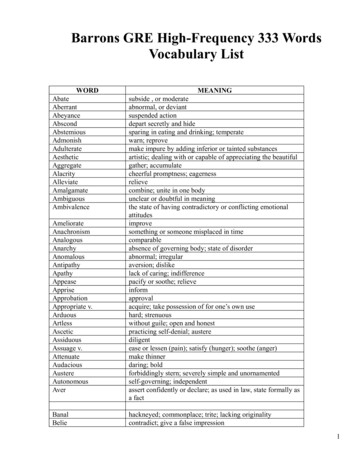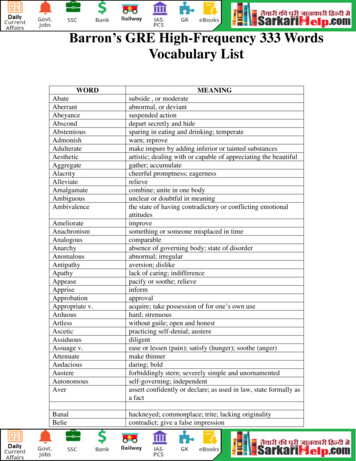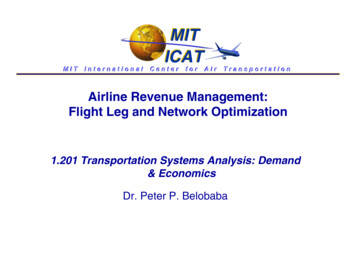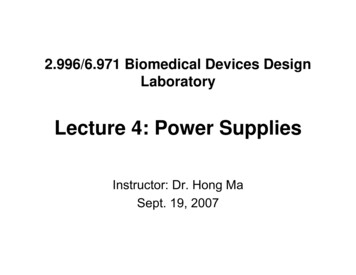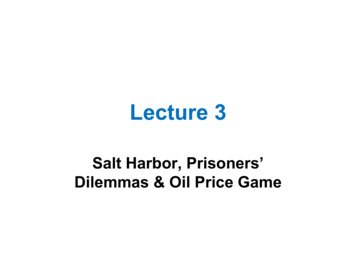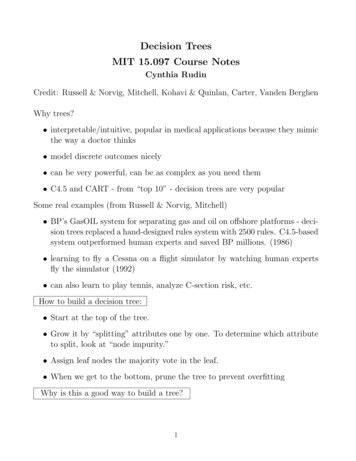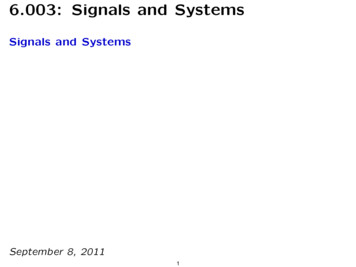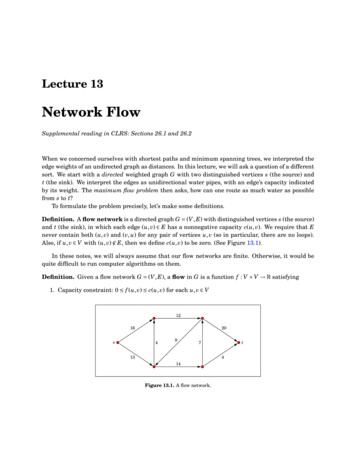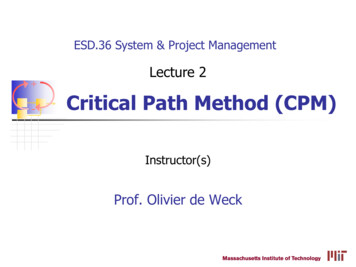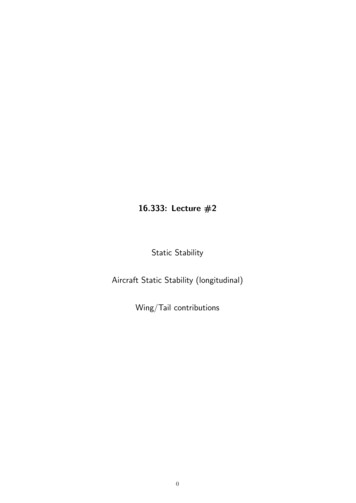
Transcription
16.333: Lecture #2Static StabilityAircraft Static Stability (longitudinal)Wing/Tail contributions0
Fall 200416.333 2–1Static Stability Static stability is all about the initial tendency of a body toreturn to its equilibrium state after being disturbed To have a statically stable equilibrium point, the vehicle must developa restoring force/moment to bring it back to the eq. condition Later on we will also deal with dynamic stability, which is concernedwith the time history of the motion after the disturbance– Can be SS but not DS, but to be DS, must be SS SS is a necessary, but not sufficient condition for DS To investigate the static stability of an aircraft, can analyze responseto a disturbance in the angle of attack– At eq. pt., expect moment about c.g. to be zero CMcg 0– If then perturb α up, need a restoring moment that pushes noseback down (negative)
Fall 200416.333 2–2 Classic analysis:– Eq at point B– A/C 1 is statically stable Conditions for static stabilityCM 0;note that this requires CM α0 CM CMα 0 α 0 Since CL CLα (α α0) with CLα 0, then an equivalent conditionfor SS is that CM 0 CL
Fall 200416.333 2–3Basic AerodynamicsLwc.g.MacwiwZcgDw w FRLFuselage ReferenceLine (FRL)XacWing mean chordXcg Take reference point for the wing to be the aerodynamic center(roughly the 1/4 chord point)1 Consider wing contribution to the pitching moment about the c.g. Assume that wing incidence is iw so that, if αw αF RL iw , thenαF RL αw iw– With xk measured from the leading edge, the moment is:Mcg (Lw cos αF RL Dw sin αF RL)(xcg xac) (Lw sin αF RL Dw cos αF RL)(zcg ) Macw– Assuming that αF RL 1,Mcg (Lw Dw αAF RL)(xcg xac) (Lw αF RL Dw )(zcg ) Macw– But the second term contributes very little (drop)1 The aerodynamic center (AC) is the point on the wing about which the coefficient of pitching moment is constant. On all airfoilsthe ac very close to the 25% chord point ( / 2%) in subsonic flow.
Fall 200416.333 2–4 Non dimensionalize:CL L122 ρV SCM M122 ρV Sc̄ Gives:CMcg (CLw CDw αF RL)(xcg xac ) CMacc̄c̄ Define:– xcg hc̄ (leading edge to c.g.)– xac hn̄c̄ (leading edge to AC) ThenCMcg (CLw CDw αF RL)(h hn ) CMac (CLw )(h hn ) CMac CLαw (αw αw0 )(h hn ) CMac Result is interesting, but the key part is how this helps us analyze thestatic stability: CMcg (h hn̄) 0 CLwsince c.g. typically further back that AC– Why most planes have a second lifting surface (front or back)
Fall 200416.333 2–5Contribution of the TailltLwMacwDwiwLtc.g.MactZcgwitFRLDtZcgtFRL W FRLV VV' Some lift provided, but moment is the key part Key items:1. Angle of attack αt αF RL it , is wing downwash2. Lift L Lw Lt with Lw Lt andStCL CLw η CLtSη (1/2ρVt2)/(1/2ρVw2) 0.8–1.2 depending on location of tail3. Downwash usually approximated asd αwdαwhere 0 is the downwash at α0. For a wing with an ellipticdistribution2CLαw2CLwd πARdαπAR 0
Fall 200416.333 2–6 Pitching moment contribution: Lt and Dt are , to V not V αF RL to FRL, so must rotate and– So they are at angle αthen apply moment arms lt and zt.Mt Dt sin α] lt [Lt cos α zt [Dt cos α Lt sin α] Mact First term largest by far. Assume that α 1, so that Mt ltLt1Lt ρVt2StCLt2CMtMtlt 12 ρVt2StCLt 1 2 c̄ 21 ρV 2S2 ρV Sc̄ltSt ηCLtSc̄ Define the horizontal tail volume ratio VH lt StSc̄ ,so thatCMt VH ηCLt Note: angle of attack of the tail αt αw iw it , so thatCLt CLαt αt CLαt (αw iw it )where 0 α αw So thatCMt VH ηCLαt (αw iw it ( 0 α αw )) VH ηCLαt ( 0 iw it αw (1 α ))
Fall 200416.333 2–7 More compact form:CMt CM0t CMαt αw CM0t VH ηCLαt ( 0 iw it) CMαt VH ηCLαt (1 α )where we can chose VH by selecting lt, St and it Write wing form as CMw CM0w CMαw αw CM0w CMac CLαw αw0 (h hn̄) CMαw CLαw (h hn̄) And total is:CMcg CM0 CMα αw CM0 CMac CLαw αw0 (h hn̄) VH ηCLαt ( 0 iw it) CMα CLαw (h hn̄) VH ηCLαt (1 α )
Fall 200416.333 2–8 For static stability need CM 0 and CMα 0– To ensure that CM 0 for reasonable value of α, need CM0 0 use it to trim the aircraft For CMα 0, consider setup for case that makes CMα 0– Note that this is a discussion of the aircraft cg location (“find h”)– But tail location currently given relative to c.g. (lt behind it),which is buried in VH need to define it differently Define lt c̄(ht h); ht measured from the wing leading edge, thenVH ltSt St (ht h)c̄SSwhich givesCMα CLαw (h hn ) h(CLαw ηSt(ht h)ηCLαt (1 α )SStStCLαt (1 α )) CLαw hn̄ htη CLαt (1 α )SS A bit messy, but note that if LT Lw Lt, thenCLT CLw ηStCLS tso thatCLT CLαw (αw αw0 ) ηStCL ( 0 iw it αw (1 α ))S αt CL0T CLαT αwwith CLαT CLαw η SSt CLαt (1 α )
Fall 200416.333 2–9 Now have thatCMα hCLαT CLαw hn htηStCL (1 α )S αt Solve for the case with CMα 0, which gives h hn̄ Note that with γ CLαwCLαTCLαTCLαwh St CLαt η ht(1 α )S CLαT 1, thenhn (γ 1)ht hN Pγwhich is called the stick fixed neutral point Can rewrite as CMα CLαT h hn̄CLαwCLαT ηSt CLαtht(1 α )S CLαT CLαT (h hN P )which gives the pitching moment about the c.g. as a function of thelocation of the c.g. with respect to the stick fixed neutral point– For static stability, c.g. must be in front of NP (hN P h)
Fall 200416.333 2–10 Summary plot: (a CLαT ) and (hn hN P )Cmh hnCG aftCm Cm a(h - hn) 0Cm0h hn 0h hnCG forward Observations:– If c.g. at hN P , then CMα 0– If c.g. aft of hN P , then CMα 0 (statically unstable)– What is the problem with the c.g. being too far forward?
Fall 200416.333 2–11Control Effects Can use elevators to provide incremental lift and moments– Use this to trim aircraft at different flight settings, i.e. CM 0Horizontal tail e Deflecting elevator gives:ΔCL dCLdδe δe CLδe δe, with CLδe 0 CL CLα (α α0) CLδe δeCm e 0Original trim 0Final trimΔCm dCmdδe δe Cm e 0 Cmδe δe, with Cmδe 0 Cm Cm0 Cmα α Cmδe δeCL e 0 e 0Finaltrimpt.Original trim pt. CL0
Fall 200416.333 2–12 For trim, need Cm 0 and CLTRIM Cmα CmδeαT RIM Cm0 CLα CLδe(δe)TRIMCLTRIM CLα α0So elevator angle needed to trim:(δe)TRIM CLα Cm0 Cmα (CLTRIM CLα α0)Cmα CLδe CLα Cmδe Note that typically elevator down is taken as being positive Also, for level flight, CLTRIM W/(1/2ρV 2S), so expect (δe)TRIMto change with speed.
h h h N P γ which is called the stick fixed neutral point Can rewrite as C Lα C w S t C Lαt Mα Lα T h n η t (1 α) C Lα T S C Lα T C Lα T (h h N P) which gives the pitching moment about the c.g. as a function of the location of the c.g. with respect to the stick fixed neutral point – For static stability, c.g .
